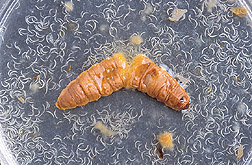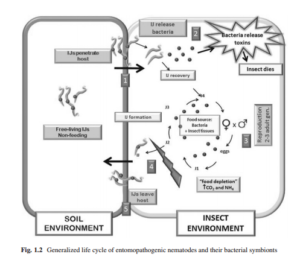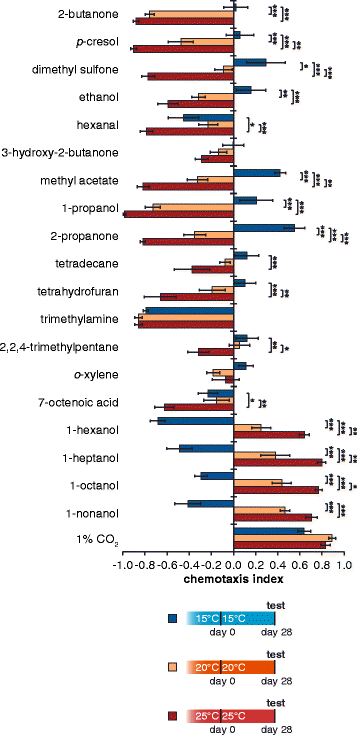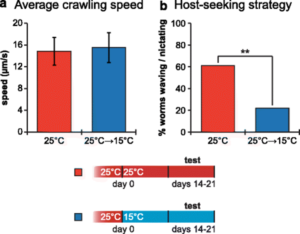
Insect damage to crops poses a significant threat to food security and accounts for billions of dollars’ worth of damage annually. While a number of control methods, such as chemical insecticides, natural pesticides and transgenic plants, are available and readily used to deter insect pests, their widespread use has raised concerns due to their untargeted detrimental impact on health and the environment. A safer alternative is the application of biocontrol via entomopathogenic nematodes (EPNs), which are widespread and deadly parasites of insects. A number of EPN species are available commercially with both a broad and specific host range suitable for a variety of different environments.
Entomopathogenic nematodes
Parasitic entomopathogenic nematodes (EPNs) of the genera Steinernema and Heterorhabditis specifically target insects, providing several advantages as biocontrol agents in that they are non-invasive, safe to humans and the environment and amenable to low-cost mass production.

EPNs infect insects as developmentally-arrested infective juveniles (IJs). Following the identification and infection of a host, the IJs quickly kill the host via the release of endosymbiotic bacteria from the gut, and continue to develop and reproduce until resources become exhausted. The new IJs then surface from the host cadaver in search of new hosts. The host seeking behaviour may be as an ambusher that awaits passing hosts, or as a cruiser that actively seeks out hosts, although these behaviours are not mutually exclusive and intermediate forms exist. While the host-seeking tactics vary, all IJs actively respond to host chemosensory cues and are attracted to CO2 as well a varied assortment of host-specific odourants.
Variability in host-seeking responses
The attraction of EPNs to a chemical stimulus produced by potential hosts is a recognised means of host location; however, why EPNs show variable efficacy in the field is not fully understood. Several variables have been shown to influence EPN effectiveness, including temperature, humidity, soil type, and timing of application. A more surprising attribution was the discovery that olfactory behaviour towards host-specific odours appears to vary depending on IJ cultivation temperature and age. Could temperature and age further influence EPNs through the host seeking behaviour strategy employed or the degree to which an odourant is attractive or repulsive? In order to investigate this, Lee and colleagues assessed the effects of temperature and IJ age on the host-seeking strategy behaviour of six EPN species, as well as the rat parasitic nematode Strongyloides ratti.
Fussy nematodes
Steinernema carpocapsae, an EPN with a widespread distribution commonly used for biocontrol was used in their study.

Changes in olfactory behaviour to a diverse panel of known chemical EPN attractants, repellents and odours identified from potential hosts were identified, when the nematodes were cultivated at either 15oC, 20oC or 25oC. Use of a chemotaxis assay four weeks after emergence from the host revealed dramatic differences in their olfactory preferences as a function of cultivation temperature. Interestingly, these effects were reversible.
Acclimating the IJs to a different temperature over two weeks changed their preferences to those odours that were attractive/repellent at distinct temperatures. By further testing response to selected odours every two days following the temperature swap, temperature-induced changes in olfactory preferences were shown to occur gradually over days to weeks. This olfactory plasticity is in line with a natural response to seasonal temperature variation, but not day to day temperature variability.
Odour preferences at the distinct temperatures tested were also shown to be highly stable. Cultivation of IJs at room temperature and subsequent temperature swapping to 15oC at day of emergence, and maintenance therein for four months, demonstrated that after the initial temperature-mediated change in olfactory behaviour the olfactory preferences remained unchanged at the constant temperature condition.
To investigate whether olfactory plasticity is conserved across EPNs, five other species had their responses to an odorant-panel examined under the same cultivation conditions. Interestingly, Heterorhabditis bacteriophora olfactory responses changed primarily as a function of IJ age and were not significantly influenced by cultivation temperature.
The four other EPNs showed both age- and temperature-dependent changes in olfactory behaviour to varying degrees, demonstrating broad conservation of the olfactory-mediating effects across EPNs. Temperature-dependent olfactory plasticity was also observed in the mammalian-parasitic nematode S.ratti when using a panel of mammalian-derived odours applied after temperature swapping.

Are you coming or going?
Host-seeking strategy is another fundamental aspect of EPN biology, could this also be influenced by cultivation temperature? In order to answer this, the group then assessed Ste. carpocapsae IJs, characteristically classified as an ambusher, for motility changes, nictation (an ambushing behaviour where an IJ stands on its tail and waves its head to facilitate host attachment) and host-seeking behaviour at different temperatures. Using automated worm-tracking, motility was not shown to be influenced by remaining at the cultivation temperature of 25oC or by temperature switching to 15oC immediately after emergence from host. However, assays using ‘micro-dirt’ chips revealed that IJs remaining at 25oC had a greater tendency to nictate than those that were temperature swapped, indicating Ste. carpocapsae acts as an ambusher at higher temperatures and more like a cruiser at lower temperatures. Therefore, Ste. carpocapsae employs flexible switching in host seeking behaviour in response to changing environmental conditions.
Conclusion
EPNs show great promise as a biocontrol agent and do not come with the disadvantages associated with other insecticidal products. While their efficacy in the field has been inconsistent and precluded their widespread adoption, research is beginning to unravel the complexities of host-seeking responses and their amenability to context-dependent modulation. Recent research has shown that parasitic nematodes alter their olfactory preferences in response to external cues such as temperature and internal cues such as age, and suggests promise for enhancing EPNs practical utility in the field.

Comments